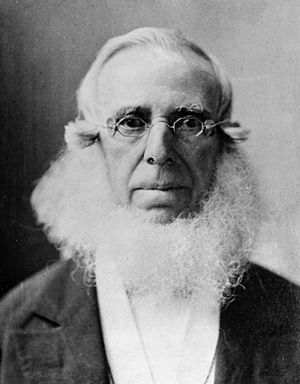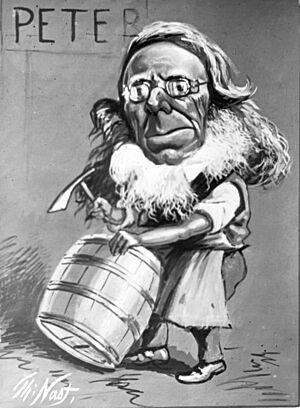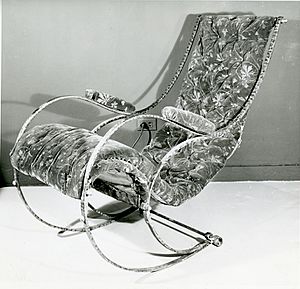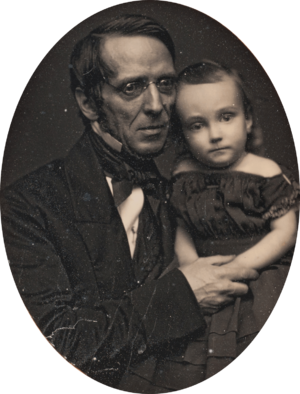Peter Cooper facts for kids
Quick facts for kids
Peter Cooper
|
|
|---|---|
 |
|
| Personal details | |
| Born | February 12, 1791 New York City, U.S. |
| Died | April 4, 1883 (aged 92) New York City, U.S. |
| Political party | Greenback |
| Spouse |
Sarah Raynor Bedell
(m. 1813; died 1869) |
| Children | 2, including Edward |
| Signature |  |
Peter Cooper (February 12, 1791 – April 4, 1883) was an American businessman, inventor, and helper of others (a philanthropist). He also had a career in politics. He is famous for designing and building the first American steam locomotive, called the Tom Thumb.
Peter Cooper also started a special school called the Cooper Union for the Advancement of Science and Art. He was its first president. Later in life, he ran for president of the United States in 1876 for the Greenback Party. At 85 years old, he was the oldest person ever to be nominated for president.
Cooper started inventing things when he was young. He worked many different jobs in New York City. In 1821, he bought a glue factory. He used the money he made from the glue factory to start the Canton Iron Works. There, he built the Tom Thumb locomotive, which made him even more money. Cooper was very successful as a businessman and inventor. He was the first factory owner to successfully use anthracite coal to make iron. He also created many inventions, like a way to make gelatin. He even helped lay the first transatlantic telegraph cable across the ocean.
During a time called the Gilded Age, Cooper believed that the government should print its own money instead of banks. He ran for president in 1876. He and his running mate, Samuel Fenton Cary, received a small percentage of the votes. His son, Edward, and his son-in-law, Abram Hewitt, both became Mayor of New York City.
Contents
Early Life and Work
Peter Cooper was born in New York City on February 12, 1791. His family had roots from the Netherlands, England, and France. His father, John Cooper, was a hatmaker. Peter worked many different jobs when he was young. He was an apprentice for a coachmaker, a cabinet maker, a hatmaker, a brewer, and a grocer.
He loved to tinker and invent things. He created a machine to cut cloth. He also designed a special chain to pull barges and boats on the new Erie Canal. The governor of New York, DeWitt Clinton, liked his idea. However, Cooper could not sell his invention.
In 1821, Cooper bought a glue factory in Manhattan. He paid $2,000 for it. The factory was near slaughterhouses, which provided the raw materials he needed. He made a lot of money from this business. In just two years, he earned $10,000 in profit. He found new ways to make glues, cements, and gelatin. His factory became the main supplier for tanners and paint makers in the city. Eventually, the factory's waste polluted the nearby pond. So, in 1839, the pond had to be drained.
Business Successes

Peter Cooper believed that a new railroad, the Baltimore and Ohio Railroad, would make land prices go up in Maryland. In 1828, he used his glue factory profits to buy 3,000 acres of land there. While developing the land, he found iron ore. He saw that the Baltimore and Ohio Railroad would need iron for its tracks.
So, he started the Canton Iron Works in Baltimore. When the railroad had problems with its engines, Cooper built a steam locomotive for them in 1829. He used old parts, even musket barrels, to create the Tom Thumb. This engine was a huge success! It made investors want to buy stock in the railroad. This allowed the railroad to buy Cooper's iron rails. This is how he made his first fortune.
In 1836, Cooper started an iron factory in New York. He was the first to successfully use anthracite coal to make iron. Later, he moved his factory to Trenton, New Jersey. This was closer to where he could get raw materials. His son, Edward Cooper, and his son-in-law, Abram S. Hewitt, later made the Trenton factory much bigger. It became a huge complex that employed 2,000 people.
Cooper also had a successful glue factory in Gowanda, New York. This factory made glue for many years. Gowanda became known as America's "glue capital."
Peter Cooper held many patents for his inventions. Some of these were for making gelatin. He even set standards for how gelatin should be made. Later, his patents were sold to a company that made cough syrup. This company developed a pre-packaged form of gelatin that his wife named "Jell-O".
Cooper also invested in real estate and insurance. He became one of the richest men in New York City. Even though he was very wealthy, he lived a simple life. He wore plain clothes and had only two servants. When his wife bought a fancy carriage, he returned it for a simpler, cheaper one.
In 1854, Cooper helped create the New York, Newfoundland and London Telegraph Company. He also helped form the American Telegraph Company in 1855. These companies helped build the telegraph network in America. In 1858, he helped supervise the laying of the first Transatlantic telegraph cable across the Atlantic Ocean.
First Steel Rocking Chair
In the 1830s, Peter Cooper designed the first steel chair in America. It was a rocking chair. Cooper's design was very simple and modern. It was different from the fancy, decorated furniture of that time. Most rocking chairs had separate rockers attached to the legs. But Cooper's chair used the curve of its own frame to create the rocking motion.
His chair was made of steel or wrought iron. It had soft fabric stretched across the frame for comfort. This chair was made in Britain by R.W. Winfield & Co. They showed the chair at big exhibitions in London in 1851 and 1862.
Political Ideas and Career
In 1840, Peter Cooper became an alderman in New York City. An alderman is like a city council member.
Before the Civil War, Cooper was active in the anti-slavery movement. He believed in using Christian ideas to solve social problems. During the war, he strongly supported the Union (the North). He also believed the government should print paper money.

Peter Cooper was influenced by a writer named Lydia Maria Child. He became involved in helping Native Americans. He started a group called the United States Indian Commission. This group wanted to protect Native Americans and stop wars in the western territories.
Cooper's efforts led to the creation of the Board of Indian Commissioners. This group helped oversee President Ulysses S. Grant's plan for peace with Native American tribes. Between 1870 and 1875, Cooper helped bring Native American leaders to cities like Washington, D.C. and New York City. These leaders spoke to the public about Native American rights. Famous speakers included Red Cloud and Little Raven.
Cooper strongly disagreed with the gold standard. He believed that the money system, which relied on banks and debt, was a problem. He thought the government should print its own money, called United States Notes. In 1883, his speeches and writings about public issues were put into a book called Ideas for a Science of Good Government.
Running for President
People encouraged Peter Cooper to run for president in the 1876 United States presidential election. He ran for the Greenback Party. He knew he probably would not win. His running mate was Samuel Fenton Cary. The campaign cost more than $25,000.
At 85 years old, Cooper was the oldest person ever nominated for President of the United States by any political party. The election was won by Rutherford B. Hayes of the Republican Party.
A Family in Politics
In 1813, Peter Cooper married Sarah Bedell (1793–1869). They had six children, but only two lived past the age of four. These were their son, Edward, and their daughter, Sarah Amelia. Edward later became Mayor of New York City. Sarah Amelia's husband, Abram S. Hewitt, also became Mayor of New York City. He was also an inventor and industrialist.
Peter Cooper's granddaughters, Sarah Cooper Hewitt, Eleanor Garnier Hewitt, and Amy Hewitt Green, founded a museum in 1895. It was originally called the Cooper-Hewitt Museum. Today, it is known as the Cooper Hewitt, Smithsonian Design Museum. It was first part of Cooper Union, but since 1967, it has been part of the Smithsonian Institution.
Religious Beliefs
Peter Cooper was a Unitarian. He often attended services at the Church of All Souls (New York). His beliefs were very open-minded and did not stick to one specific religious group. In 1873, he wrote about his hope for a future where religious teachers would focus on love and unity.
Cooper Union School
For many years, Peter Cooper was very interested in adult education. He led a group that ran free schools in New York City. In 1848, this group started offering evening classes. Cooper had an idea for a free school in New York, similar to a polytechnic school in Paris. This school would offer free practical education in science and mechanical arts. It would help young working men and women succeed in business.
In 1853, he started building the Cooper Union for the Advancement of Science and Art. He finished the building in 1859, and it cost $600,000. Cooper Union offered free night classes to both men and women. About 2,000 people signed up at first. The classes were open to everyone, no matter their religion. Women were treated equally to men. Cooper also started a Women's School of Design. This school offered daytime classes in things like engraving, painting, and drawing.
The new school quickly became important to the community. Its Great Hall was a place where important issues of the day could be discussed. Even radical ideas were allowed to be debated there. Also, the school's library stayed open until 10:00 at night. This was helpful for working people who wanted to use the library after their jobs.
Today, Cooper Union is known as one of the best colleges in America for architecture, engineering, and art. Peter Cooper believed that college education should be free. For many years, Cooper Union gave all its students full scholarships. The college is working to bring back full scholarships for all students by 2029.
Helping Others
In 1851, Peter Cooper helped start Children's Village. This organization was originally an orphanage called "New York Juvenile Asylum." It is one of the oldest non-profit groups in the United States.
Death and Legacy
Peter Cooper passed away on April 4, 1883, at 92 years old. He is buried in Green-Wood Cemetery in Brooklyn, New York.
Many places are named in his honor. Besides Cooper Union, there is the Peter Cooper Village apartment complex in Manhattan. There is also the Peter Cooper Elementary School in Ringwood, New Jersey, and the Cooper School in Superior, Wisconsin. Other places include the Peter Cooper Station post office, Cooper Park in Brooklyn, Cooper Square in Manhattan, and Cooper Square in Hempstead, New York.
Images for kids
See also
 In Spanish: Peter Cooper para niños
In Spanish: Peter Cooper para niños








